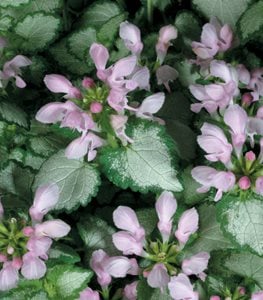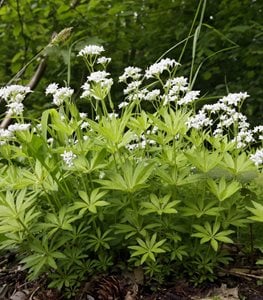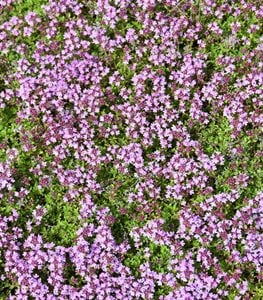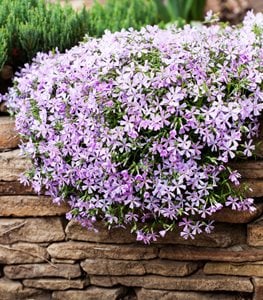14 Ground Cover Plants for Shade or Sun
14 easy-care plants that solve a multitude of problems while carpeting your garden with beautiful color and texture.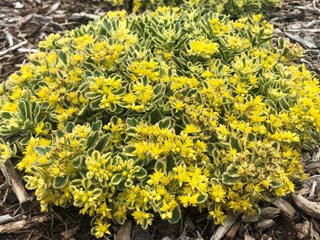
Rock 'N Low™ 'Boogie Woogie' (Sedum hybrid) Photo by: Proven Winners.
Ground covers are the ultimate troubleshooters: they overpower weeds, fill in bare spots under trees, control erosion on slopes, and hide fading foliage of spring bulbs. Some also thrive in unfavorable conditions where nothing else will grow, such as rocky soils or deep shade. Even in relatively trouble-free gardens, nothing beats these fast-growing spreaders for quickly blanketing open spaces with a dense mass of beautiful foliage. As a bonus, many also put on a seasonal display of spectacular flowers.
Whether you need a ground cover for sun, shade, or somewhere in between, there are many options to choose from. Here are some of our top picks, all of which need little attention once established.
On this page: Ground Covers for Shade | Ground Covers for Sun
GROUND COVERS FOR SHADE
BISHOP’S HAT (Epimedium hybrids)
Also called barrenwort, this exceptional ground cover combines beautiful foliage and flowers. Heart-shaped leaves that are bright lime green with red accents, emerge in spring. In summer, the leaves become darker green, and turn bronzy red in fall. Clusters of small flowers bloom early-to-mid spring.
Zones: 5-9
Height/Spread: 6 to 12 inches tall, spreads up to 2 feet
Special attributes: Drought tolerant; no serious pest or disease problems; evergreen in milder climates.
Where to use: Woodland gardens; shady sites with moist soil; under large trees.
Plants to try: Red barrenwort (crimson and white flowers), ‘Pink Champagne’ (pink flowers with raspberry centers), 'Sulphureum' (light yellow flowers, bright red stems)
BLUE LILYTURF (Liriope muscari)
With narrow, arching leaves and tidy clump-forming habit, lilyturf could easily pass for an ornamental grass; but in midsummer, it sends up showy spikes of white, lavender, or pink flowers. The grasslike foliage—dark green or variegated—grows almost anywhere, from full shade to full sun.
Zones: 6-10
Height/spread: 10 to 15 inches tall, spreads 12 to 18 inches
Special attributes: Drought tolerant; grows in most soil types.
Where to use: Woodland gardens; erosion control on slopes; under trees and shrubs; as low edging.
Plants to try: ‘Monroe White’ (dark green leaves, white flowers), 'Variegata' (white and green variegated leaves, lavender flowers), ‘Gold-banded’ (wider leaves with gold borders, lavender flowers)
BUGLEWEED (Ajuga reptans)
This resilient perennial plant spreads quickly and blankets the ground with foliage in shades ranging from mint green to burgundy, often splashed with pink or white. Showy flower spikes (dark blue, pink, or white) bloom in late spring through early summer. Cut back to the ground after flowers fade to encourage fresh foliage. Read more on how to grow bugleweed.
Zones: 3-9
Height/spread: 3 to 6 inches tall, spreads 2 feet or more
Special attributes: Heat- and drought-tolerant; withstands light foot traffic; evergreen in milder climates.
Where to use: Adapts to a wide range of soil conditions and light levels, from deep shade to full sun. For the best foliage color, grow in a spot that receives some sun exposure.
Plants to try: ‘Burgundy Glow’ (variegated green, pink, and white foliage; pictured), ‘Chocolate Truffles’ (nearly black foliage), ‘Pink Lightning’ (variegated mint-green and white foliage)
JAPANESE PACHYSANDRA (Pachysandra terminalis)
A lush ground cover for shade, spreads slowly by rhizomes to form a carpet of glossy, emerald-green foliage. Oval leaves are topped by short spikes of white flowers in early spring. Although sweetly scented blooms are short-lived, evergreen foliage remains attractive year-round. Also try Allegheny spurge (Pachysandra procumbens), a native American species with blue-green leaves that turn bronze in fall.
Zones: 5-9
Height/spread: 6 to 12 inches tall, spreads 1 to 1-1/2 feet
Special attributes: Drought tolerant once established; deer and rabbit resistant.
Where to use: Under shade trees; in woodland gardens; on north-facing slopes. Avoid sunny locations.
Plants to try: ‘Green Carpet’, ‘Green Sheen’ (glossy deep-green foliage), 'Silver Edge' (blue-green leaves with silver margins)
SPOTTED DEADNETTLE (Lamium maculatum)
A versatile ground cover adaptable to a wide range of growing conditions, most soil types, and tolerates part shade to full sun. Scalloped leaves come in a variety of color variations and remain attractive all season. Colorful flower spikes bloom from late spring through early summer in white, pink, rose, or violet.
Zones: 3-8
Height/spread: 6 to 8 inches tall, spreads up to 2 feet
Special attributes: Deer and rabbit resistant; long bloom period; foliage is evergreen in milder climates.
Where to use: Transition areas between shade and sun; beneath trees or shrubs; or brighten shady areas. Can become invasive* in certain areas, see where.
Plants to try: Proven Accents® Pink Chablis® (silver and green foliage, light pink flowers; pictured), ‘White Nancy’ (green and silver leaves, white flowers), ‘Anne Greenaway’ (dark/light green, chartreuse, and silver foliage; purple flowers)
SWEET WOODRUFF (Galium odoratum)
A favorite in woodland gardens, this enchanting ground cover bears clusters of tiny white flowers in spring. It loves heavy shade and rich, loamy soil, where it will spread far and wide by trailing roots. When crushed or rubbed, the foliage has the sweet scent of newly mown hay. The flowers are also lightly fragrant.
Zones: 4-8
Height/spread: 6 to 12 inches tall, spreads 12 to 18 inches
Special attributes: Deer and rabbit resistant; fragrant flowers and foliage.
Where to use: Ideal for woodland gardens and naturalizing. Can become invasive* if given the right conditions. Plant where you can control it easily. See where this plant may become invasive.
MONDO GRASS (Ophiopogon japonicus and Ophiopogon planiscapus)
Often confused with liriope, but leaves are narrower and flowers smaller. The evergreen, grasslike foliage comes in a variety of colors as well as variegated. Plants grow in tight clumps, with the leaves emerging from rhizomes just below the surface. Prefers shade, but also does well in sunnier locations.
Zones: 6-11
Height/spread: 2 to 12 inches tall, spread depends on the variety
Special attributes: Nearly indestructible. Tolerates tough situations, including temporary standing water as well as drought.
Where to use: Rock gardens; slopes; along pathways; pond edges; as turf substitute under trees.
Plants to try: 'Gyoku-Ryu' (only 2 inches tall), 'Variegatus' (green and silver foliage), O. planiscapis ‘Nigrescens’ (dark purple, nearly black leaves)
GROUND COVERS FOR SUN
CREEPING THYME (Thymus spp)
This low-growing aromatic herb is highly resilient to foot traffic and a great filler between stepping stones and pathways. Fragrance is released when leaves are crushed or stepped on. Many also produce tiny flowers that completely cover the plants in spring. Unlike the culinary herb (Thymus vulgaris), creeping thyme is primarily ornamental. Read more on how to grow creeping thyme.
Zones: 4-10
Height/spread:1 to 4 inches tall, spreads up to a foot or more
Special attributes: Heat and drought tolerant; attracts butterflies; fragrant foliage.
Where to use: Rock gardens; herb gardens; along garden paths; as a lawn substitute.
Plants to try: 'Coccineus’ (dark green leaves, magenta flowers), ‘Pink Chintz’ (fuzzy gray-green leaves, salmon-pink flowers), ‘Purple Carpet’ (dark green leaves, bright lavender-purple flowers)
CREEPING PHLOX (Phlox subulata)
Few ground covers can match the beauty of creeping phlox when it blooms in spring. Unlike taller garden phlox, it grows to a height of only 6 inches, covering the ground with a carpet of colorful flowers in shades of lavender, pink, rose, and purple. Blooms last for weeks—often through early June—leaving behind evergreen, needle-like foliage.
Zones: 3-9
Height/spread: 3 to 6 inches tall, spreads 18 to 24 inches
Special attributes: Heat and drought resistant; attracts butterflies.
Where to use: Rock gardens; slopes; cascading over retaining walls; along garden paths.
Plants to try: Mountainside™ ‘Crater Lake', (indigo-blue flowers) ‘Candy Stripe’ (white flowers with pink stripes), ‘Drummond’s Pink’ (bright pink flowers with deep pink eyes)
ICE PLANT (Delosperma spp.)
This gorgeous flowering succulent is unfazed by summer heat. The common name is inspired by the calcium crystals that form on the leaves of some varieties. Narrow, needle-like foliage is covered most of the summer with vibrantly colored flowers. Well-drained soil and bright light is all this easy-care ground cover needs. Read more on how to grow ice plant.
Zones: 5-9
Height/spread: 3 to 6 inches tall, spreads 12 to 24 inches
Special attributes:Drought and heat tolerant; long blooming.
Where to use: Rock gardens; xeriscapes.
Plants to try: Fire Spinner® (orange, red, and lavender blooms; pictured), ‘Cooper’s Hardy Ice Plant’ (magenta-pink flowers), 'Jewel of the Desert Moonstone' (snow-white with yellow centers)
CREEPING SEDUM (Sedum spp.)
These low-growing succulents come in a variety of foliage forms and colors, including shades of blue, plum, red, purple, silver, gray-green, chartreuse, and gold. Many also put on a showy display of tiny flowers in summer. For an instant succulent garden, look for sedum “tiles", ready-to-plant mats of selected varieties.
Zones: 3-9
Height/spread: 2 to 6 inches tall, spreads up to 24 inches
Special attributes: Evergreen in warmer climates; drought tolerant; rarely bothered by pests.
Where to use: Rock gardens; slopes; rocky or sandy soils.
Plants to try: Rock 'n Low™ 'Boogie Woogie' (green and cream leaves, yellow flowers), ‘Angelina’ (chartreuse foliage, yellow flowers), ‘Dragon’s Blood’ (green leaves edged with red, dark red flowers)
CARPET ROSES (Rosa spp.)
If you love climbing and shrub roses, you’ll swoon over carpet roses, which are lower growing plants and ideal for use as a flowering ground cover. They bloom nonstop from spring through fall, producing thousands of blooms on one plant in a season. Colors range from white and soft pastels to bold reds and pinks.
Zones: 4-10
Height/spread: 2 to 3 feet tall, spreads 3 to 4 feet
Special attributes: Disease resistant; self-cleaning; drought tolerant once established.
Where to use: Cottage gardens; perennial borders; en masse for drifts of color; as a low-growing hedge.
Plants to try: Flower Carpet® Pink Supreme, Flower Carpet® Scarlet, Flower Carpet® Coral
CREEPING JUNIPER (Juniperus horizontalis)
These ground-hugging conifers are prized for their feathery needles, which range in color from blue-green to gold, depending on the cultivar. In winter, color often deepens, providing year-round interest. Sturdy, adaptable, and thrives in tough environments including coastal climates, rocky soils, and dry conditions.
Zones: 3-9
Height/spread: 3 to 6 inches tall, spreads 8 to 10 feet
Special attributes: Tolerates salt exposure, drought, and alkaline soils. Deer resistant.
Where to use: Trailing over ledges or retaining walls; on slopes.
Plants to try: ‘Bar Harbor’ (blue-green foliage that turns plum-colored in winter) ‘Blue Rug’ (very low growing with silvery blue foliage), ‘Mother Lode’ (gold foliage that changes to bronze)
LAMB’S EARS (Stachys byzantina)
Soft oblong leaves make this plant so irresistible. Their fuzzy texture and silver overtones contrast beautifully with many other garden perennials. Upright stalks of pink or purple flowers in early summer add to the overall height, but you can find cultivars that bloom rarely or not at all.
Zones: 4-9
Height/spread: 3 to 10 inches (taller when in flower), spreads up to 2 feet
Special attributes: Not bothered by pests or diseases; coordinates well with almost everything.
Where to use: Sunny spots where you need a dense, weed-suppressing ground cover.
Plants to try: ‘Big Ears' (large leaves up to 8 inches long), 'Silky Fleece' (a dwarf variety with tiny 1-inch leaves), ‘Silver Carpet’ (silvery blue foliage, nonflowering)
See more: 16 Favorite Ground Cover Flowers
*INVASIVE VS. AGGRESSIVE GROWERS
When learning about plants, it's important to understand what it means for a plant to be invasive. From the USDA website: "An invasive species is non-native to the ecosystem under consideration, and whose introduction causes or is likely to cause economic or environmental harm or harm to human health."
Keep in mind that a plant may be invasive in one environment, but okay to grow in another. So, although some of the plants above are noted as being invasive in certain regions, they are fine to grow in others.
It's also important to note that there is a difference between a plant being considered invasive and one that grows aggressively. The Universiy of Illinios Extension Service defines aggressive plants as those that have the ability to "spread fast enough within the garden as to cause issues to other garden areas where the plant is not wanted or is intended to be growing." This is not the same as being identified as being invasive.
Resources for determining if a vine or plant is invasive in your region:
- Your local extension service (search online)
- Local Master Gardener's Association (search online)
- Invasive Plant Atlas
More: Invasive Plants & What to Grow Instead
RELATED:
Lawn & Grass Alternatives for an Eco-Friendly Landscape
Amazing Annual Flowers for Sun
Amazing Annual Shade Plants






